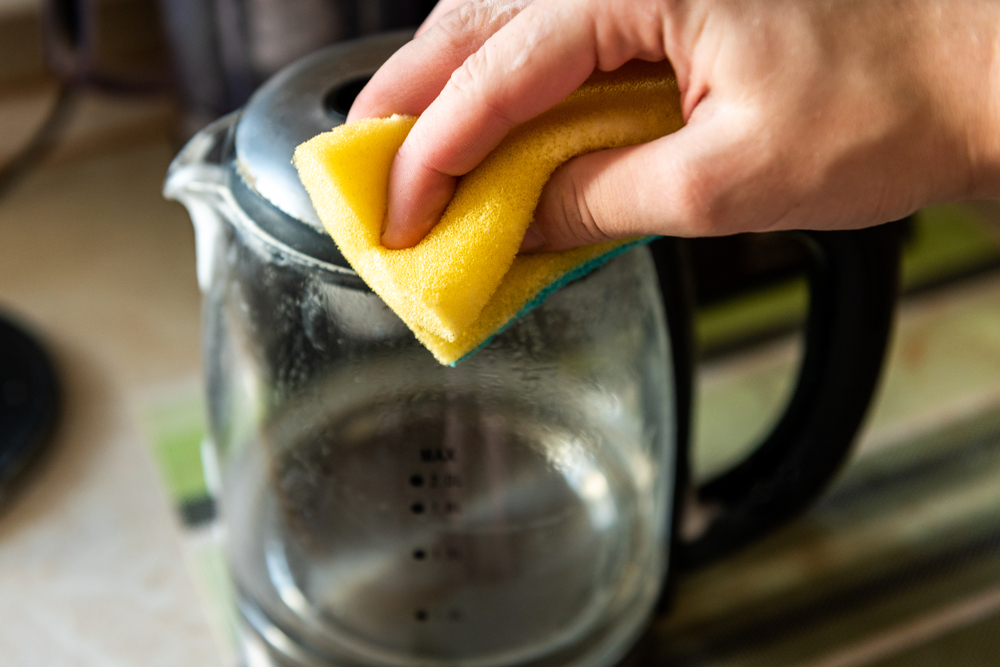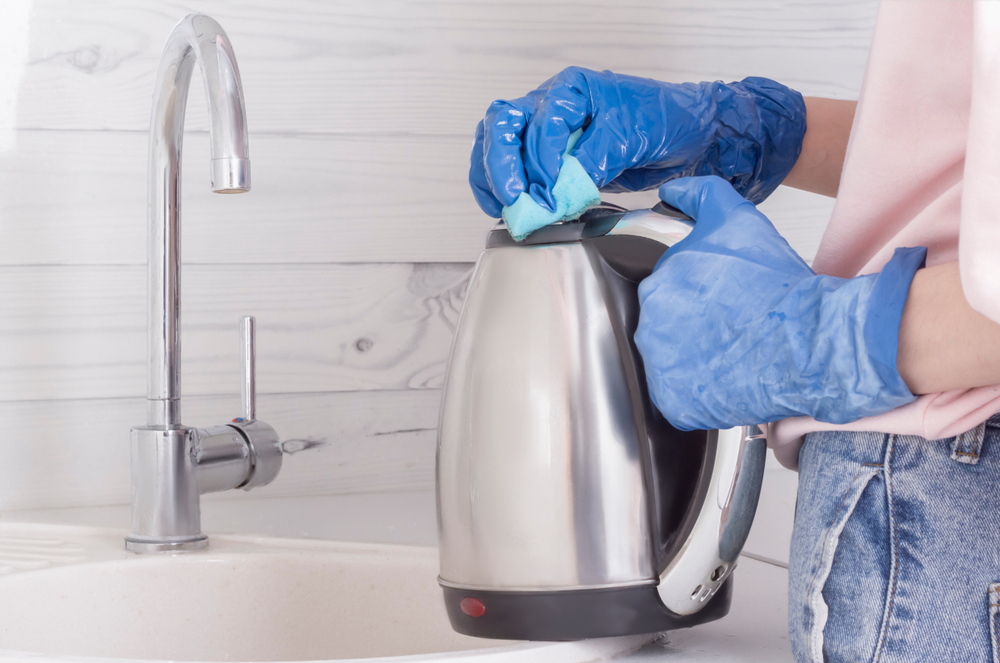Maintaining the performance of your hot water kettle and assuring the cleanliness of your brewed beverages depends on keeping it clean. The efficiency and flavor of the kettle might be impacted by the buildup of scale, residues, and mineral deposits over time. How to clean hot water kettle? However, you can quickly clean your hot water kettle and return it to its perfect state with a few simple steps and elements. You’ll always be able to enjoy a hot cup of water or a fresh, tasty cup of tea if you use these cleaning methods.

Materials Needed for Cleaning
You will need a few basic things while cleaning your hot water kettle to ensure an efficient and comprehensive cleaning operation. These are the supplies you will need:
- Distilled White Vinegar
- Water
- Lemon Juice
- Baking Soda
- Soft Brush or Sponge
- Microfiber Cloth or Towel
- Small Bowl or Container
- Kitchen Gloves
Step-by-Step Cleaning Process
Here are some step-by-step cleaning methods, how to clean your water kettle:
Emptying and Rinsing
- Remove the kettle’s plug from the power source and let it finish cooling down.
- Pour out any residual water from the kettle after taking care to carefully remove the lid.
- Rinse the kettle with warm water to get rid of any leftovers or loose particles.
Vinegar Solution Method
- Equal amounts of water and distilled white vinegar should be added to the kettle halfway.
- Bring the vinegar-water solution to a boil in the kettle by simply plugging it in or by placing it on the stove.
- Allow the mixture to simmer for 10 to 15 minutes so that the vinegar can dissolve any scale or mineral deposits that built up inside the kettle.
- After turning the kettle off and unplugging it, leave the solution in the kettle for an additional 10–15 minutes.
- Discard the vinegar-water mixture carefully, then give the kettle a good rinsing with fresh water.
Lemon Juice Method
- Squeeze the juice of two or three fresh lemons into a container.
- Lemon juice should be diluted with an equal amount of water.
- Fill the kettle approximately halfway with the lemon juice mixture.
- Bring the solution to a boil in the kettle by setting it on the burner or by plugging it in.
- Let the lemon juice’s citric acid dissolve any deposits by allowing the mixture to boil for 10 to 15 minutes.
- Allow the solution to stay in the kettle for a further 10–15 minutes after turning off and unplugging it.
- Discard away the lemon juice solution, then clean the kettle with fresh water.
Baking Soda Method
- Create a paste by mixing baking soda with a small amount of water until it forms a thick consistency.
- On the inside or outside the kettle, use the baking soda paste to remove any obstinate stains or deposits.
- Scrub the damaged areas carefully while incorporating the baking soda paste into the spots with a soft brush or sponge.
- To get rid of the residue left by the baking soda, thoroughly rinse the kettle with clean water.
Final Rinse and Drying
- To make sure all cleaning agents and residues are gone, fill the kettle with clean water and swirl it around.
- Rinse the kettle once again with additional water after emptying the water in it.
- Dry the kettle inside and out with a microfiber cloth or towel.
- Before using the kettle once more, let it thoroughly dry in the air.
Maintenance Tips for a Clean and Well-Maintained Kettle
- Regularly Empty and Rinse: After every usage, drain any residual water from the kettle and give it a good clean. This maintains the kettle residue-free and helps avoid the accumulation of mineral deposits.
- Periodically descale: Mineral deposits and limescale can build up within the kettle over time. Regularly descale the kettle with a descaling solution or vinegar and water solution to remove them. Utilize a suitable descaling technique or according to the manufacturer’s recommendations.
- Clean the Exterior: Use a moist cloth or sponge to clean off any debris, stains, or fingerprints from the kettle’s outside. Avoid using strong chemicals or abrasive cleaning that might scratch the kettle’s surface.
- Pay Close Attention to the Spout and Lid: Thoroughly clean the spout and lid, since they may contain germs or debris. To reach any difficult-to-reach areas, use a tiny brush or a cotton swab moistened in vinegar or soapy water.
- Deodorize with lemon or baking soda: If your kettle has a bad smell, you may naturally deodorize it. Bring the kettle to a boil, then add some lemon segments or a spoonful of baking soda. After letting, it sits for a bit, drain the water and give the kettle a good rinse.
- Avoid Overfilling: Don’t fill the kettle to a level where it overflows or boils over, to prevent accidents. As a result, the unwanted mess is avoided and the kettle’s cleanliness is maintained.
Conclusion
Maintaining the efficiency of your hot water kettle and making sure the cleanliness of your beverages depend on keeping it clean. Mineral buildup, limescale, and residue inside the kettle over time can reduce its performance and provide a disagreeable smell. Fortunately, maintaining a hot water kettle is a simple task that you can easily fit into your usual kitchen cleaning plan.
In this manual, we’ll look at useful methods and easy processes to assist you in fully cleaning your hot water kettle so that it’s sparkling and prepared to make your favorite beverages.
